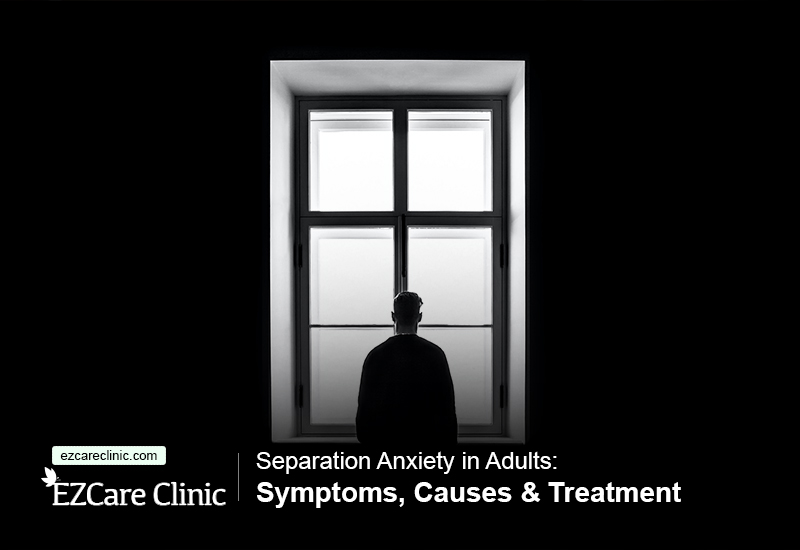Separation anxiety is a common feeling in children. Growing up, kids experience anxiety when they get separated or disconnected from close relatives and loved ones. This feeling can best be explained as a preservation mechanism to keep you from wandering too far from your parents. In most cases, you’ll realize a child feels unsafe and restless when separated from immediate family.
While this preservation technique is most dominant in children, it never really disappears. Even in adulthood, you’re still prone to experiencing separation anxiety to a certain extent. However, the fear of detachment can become overwhelming for some adults, leading to separation anxiety disorder.
Separation anxiety in adults is characterized by startling fear that something terrible could happen to your loved ones in your absence. In extreme cases, this fear of detachment can lead to significant problems and interruptions in your daily life.
What is the medical definition of separation anxiety disorder in adults? How is it diagnosed, and the available treatment options? Read on to learn more about separation anxiety in adults and the recommended preventive and remedial measures.
Looking for proper anxiety treatment? Click the button below to book your appointment.
Some of the subjects covered below include:
- What are the prevalent symptoms of separation anxiety in adults?
- How is adult separation disorder diagnosed?
- What are the main domains of adult separation anxiety?
- What causes separation anxiety disorder in adults?
- What does extreme adult separation disorder result in?
- How different is a separation anxiety disorder in children from in adults?
- What treatment options are available for adult separation anxiety disorder?
- How do you manage separation anxiety in adults?
- How can you help someone experiencing separation anxiety disorder?
The above breakdown should give you in-depth knowledge to determine whether you or someone you know suffers from separation anxiety. Additionally, this information will guide you on what to do and when to seek help.
1. What Are the Symptoms of Separation Anxiety Disorder in Adults?
The diagnostic and statistical manual for mental disorders (DSM) is the greatest resource in understanding separation anxiety disorder. However, in the fourth volume of this manual (DSM-IV), separation anxiety disorder is categorized under diseases commonly diagnosed in adolescence, childhood, or infancy. It was not until the fifth volume (DSM-V) where separation anxiety was classified as a mental condition that can affect adults.
While the core features of separation anxiety disorder remain unchanged in
Below are the most prevalent signs and symptoms associated with a separation anxiety disorder (SAD). These symptoms will give you an idea of whether you’re suffering from SAD or a different condition. However, it’s essential to seek professional help before self-diagnosing or taking subsequent measures.
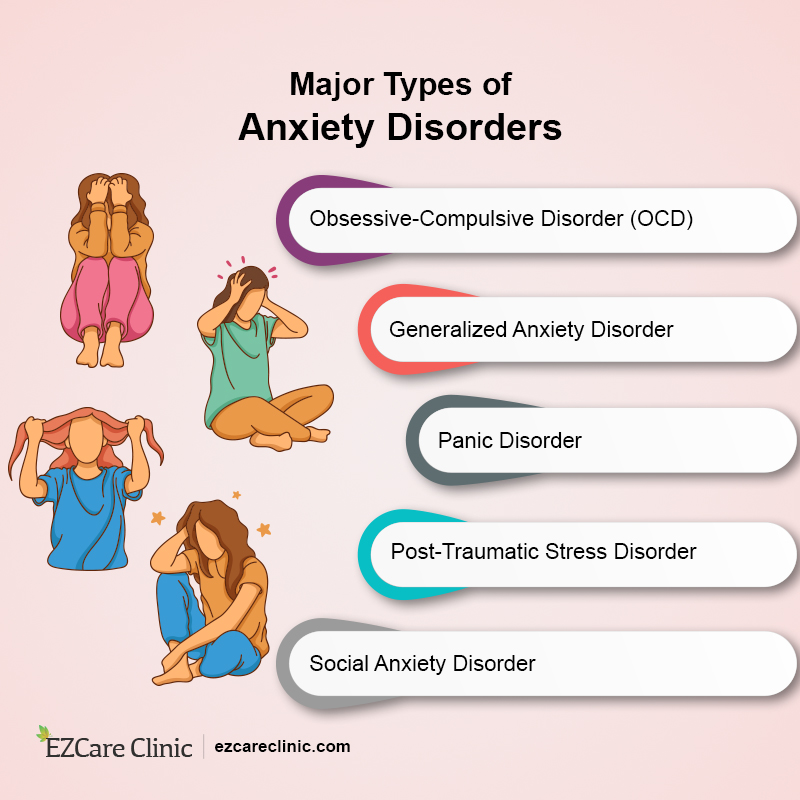
Major Types of Anxiety Disorders
The common symptoms of adult separation disorder are:
- Increased anxiety when anticipating or experiencing separation from loved ones or home.
- Excessively worrying about losing your loved ones and any harm that could befall them. This may include fear of your loved ones getting sick, into an accident, injured, or dead.
- Persistently refusing to leave the house as a result of fearing separation from family.
- Excessive fear of being alone or being detached from your loved ones at home.
- Recurring nightmares involving separation from your primary family.
- Repeated experiences with physical symptoms when separated from prominent family figures. These physical symptoms may involve headaches, nausea, stomachache, and vomiting.
- Clinically substantial distress or impairment in academic, social, and occupational functions caused by the fear of separation.
NB:
Prevalence of three or more of the above-mentioned symptoms indicates
For separation anxiety disorder to be correctly diagnosed, these symptoms should not result from other mental illnesses. Some of the closely related and overlapping symptoms may cause the subject to refuse separation due to changes in autism spectrum disorder, hallucinations, and delusions regarding separation in psychotic disorders.
2. How Is Adult Separation Disorder Diagnosed?
According to DSM-IV, SAD can only be diagnosed in infants, children, and adolescents. However, the updated DSM-V volume includes anxiety separation disorder in adults. This is following an increase in the number of adults aged 18 and over who report separation symptoms identified in DSM-V.
To be diagnosed with adult separation disorder, a qualified clinician will analyze your behavior concerning the above-mentioned symptoms. This condition is only diagnosed when the symptoms interfere with your natural development and cause significant stress to your daily life. To avoid false diagnosis or overly analyzing transient fears, these symptoms need to be present for not less than six months.
The doctor will follow an identified line of questioning to help effectively diagnose the condition. Some of the questions you might be asked include:
- Are you unable to stop feeling anxious when you’re separated from your favorite person?
- Do you experience an overwhelming fear of being alone?
- Are you overly concerned about the safety of a loved one when you’re not together?
- Are you experiencing recurring emotional outbursts?
- Do you feel the need to repeatedly call or check in with your loved ones when you’re not together?
Save yourself from the risks of anxiety. Click the banner below to book your appointment.
Factoring in the Differential Diagnosis
In some cases, more so with mental health conditions, several disorders can share symptoms. If the doctor is not careful, they could end up misdiagnosing the situation based on overlapping symptoms. To avoid this, clinicians differentiate separation anxiety disorder from other commonly misdiagnosed conditions. Some of the other mental health conditions that overlap with SAD are:
- Psychotic disorders like schizophrenia and bipolar disorder
- Generalized anxiety disorder
- Agoraphobia and panic disorders
- Conduct disorder
Adult Separation Anxiety Case Study
Separation anxiety disorder can manifest in various ways amongst adults. One case study showcasing the effects of SAD is that of a lady named Sharon. Sharon is 32 years and recently married. When she got married, she moved into her new home with her husband. Before this, Sharon had lived at home with her parents all her life.
When Sharon moved, she felt overly anxious about the health and wellbeing of her parents. She often housed disturbing feelings and thoughts of both her parents dying. A few months into her marriage, she started polarizing on the husband’s health and worrying about his safety. This would later develop into physical symptoms of acute anxiety episodes or panic attacks.
Whenever the husband left for work in the morning, Sharon could not sleep from worrying. This was even worse when he took business trips as she would repeatedly call him. If he failed to pick up, Sharon would go to his office to find out if she was okay.
After two years, Sharon presented major depressive episodes characterized by atypical depression. It was at this point she decided to consult with a psychiatrist and was put on antidepressant treatment.
This did little to improve her separation anxiety disorder, and Sharon eventually got aggressive towards her husband. However, at work, she was able to remain efficient and calm and would function excellently in her duties.
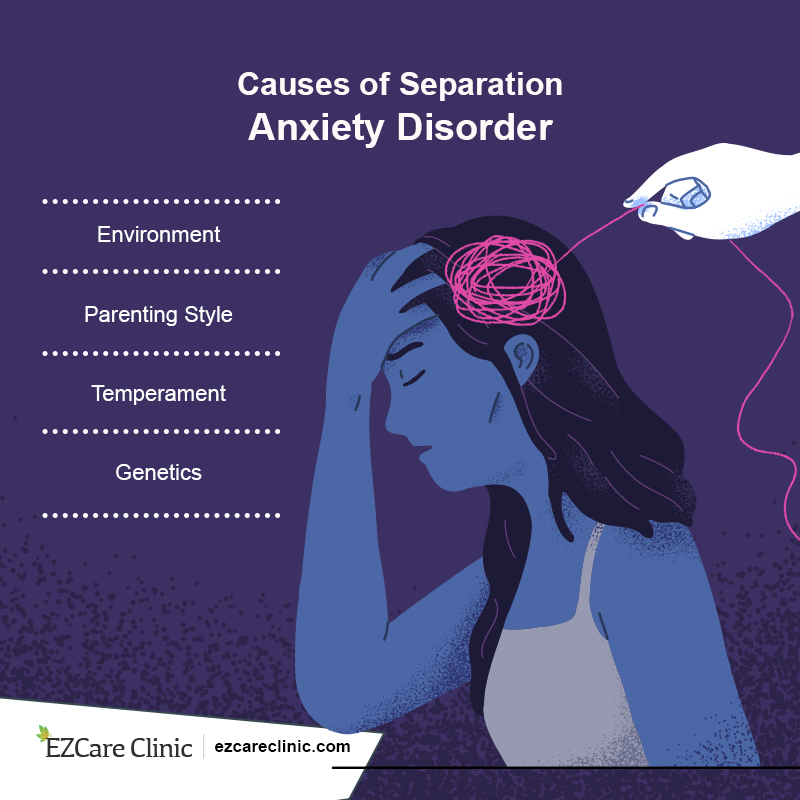
Causes of Separation Anxiety Disorder
3. What Are the Main Domains of Adult Separation Anxiety?
In children and young people, the main form of separation anxiety disorder is directly related to their parents, close relatives, and caretakers. In adults, separation anxiety can take many forms depending on your situation. Stress caused by separation anxiety in adults can be triggered by babies, parents, partners, and other factors and conditions.
Separation anxiety in adults can also result from having to shift your workplace or move far from your friends and family. Below, let’s focus on the main themes of separation anxiety disorder as depicted in adulthood experiences.
1. Adjustment Disorder and Separation Anxiety
Also known as stress response syndrome, adjustment disorder is a temporary condition describing a state where you’re unable to cope with a particular source of stress. This could include any significant change in your life, the loss of a loved one, or a particularly stressful life event.
According to DSM-V, adjustment disorder can further be broken down into five sub-categories. For example, adjustment disorder with anxiety describes a child’s inability to cope with separation from their caregiver or parent, leading to stress and difficulty adjusting.
Adults, too, can experience adjustment disorder anxiety. This can be triggered by an abrupt change in life, such as relocating to a distant location for a new job. Being away from your residence, family, friends, and support system can worsen the adjustment disorder anxiety experience.
2. Separation Anxiety from Your Baby
Parents, especially new mothers, are also prone to separation anxiety disorder. This condition is also known as maternal separation disorder or postpartum separation disorder. It is prevalent in first-time moms. Maternal separation disorder results from a parent worrying, being sad, and feeling guilty when separated from their child, even for a short time.
During child delivery, women experience a decrease in progesterone and estrogen hormones. This can leave them susceptible to experiencing stress which then results in overwhelming feelings of panic and fear. Sleep deprivation from newborn care can heighten these feelings and further aggravate the situation.
For new mothers, the responsibility of caring for the child and wanting to protect them and keep them from harm can get unbearably overwhelming. As a result, the mother will experience separation anxiety whenever they’re away from the baby.
Looking for medicinal anxiety treatment? Click the button below to book your appointment.
3. Separation Anxiety from Partners
Missing your partner is quite common and normal. When you’re away from them, it’s normal to long for their return and feeling uneasy and lonely without their presence. However, when the worry, nervousness, and emotional turmoil overwhelm you to the point of disrupting your daily life and routine, you could be experiencing separation anxiety from your partner.
These feelings of uneasiness are more than just missing your partner. In many cases, they involve a deeper apprehension that you’re unable to service without them. Separation anxiety from your partner also convinces you they’ll most likely get hurt if you’re not around them or that you may lose them forever.
4. Separation Anxiety from Pets
Pets such as dogs have been known to experience separation anxiety. However, it’s also common for pet owners to experience separation anxiety disorder if they have to be away from their pets. You can tell if you’re experiencing pet separation anxiety if you display the following signs:
- You have an irrational fear of an extraordinary circumstance happening to your pet. This could range from your pet harming themselves in your absence to them getting kidnapped or killed.
- You regularly find unjustifiable excuses to stay with your pets and avoid going to work, spending time with your family and friends, and other social events. You could also insist that your pet comes along no matter how inappropriate the scene or environment may be.
- You find it difficult to maintain attention and focus on your work and other activities as you’re worried about your pets. This can result in poor performance and slacking at work.
Get yourself treated for symptoms of anxiety. Click the banner below to book your appointment.
4. What Causes Separation Anxiety Disorder in Adults?
Separation anxiety disorder is relatively common and somewhat necessary in the early developmental ages. As mentioned above, SAD keeps children from wandering too far from their parents.
In adults, the exact underlying causes that result in separation anxiety disorder are not fully identified. While there are some plausible theories, more research is needed to identify the root cause behind separation anxiety in adults definitively. Some of the working ideas surrounding the cause of this condition include:
Biological Factors
According to one independent study, genetic predisposition may have a significant role to play in adult separation anxiety disorder. A large-scale twin study revealed genetic influence accounted for about 73% of the participant’s separation disorder. In most cases, when parents have a history of separation anxiety disorder, their children are more likely to experience the same condition.
Environmental Factors
These are factors surrounding an adult’s family and immediate environment. Some of the environmental factors that can lead to separation anxiety include:
- Lack of parental warmth during childhood and formative years
- Past traumatic events
- Separation or divorce of parents
- Extreme parental discord
Parenting Style
Your experiences and relationship with your parents while growing up can have an untold impact on your mental health and wellbeing. The relationship you form with your parents can affect your view and ability to bond with others.
Overprotective, critical, and controlling parenting styles can interfere with the child’s autonomy in life. Consequently, this can result in being overly sensitive when separated or fear being alone.
Extreme Jealousy
This refers to thoughts and feelings of fear, insecurity, and concern over a relative’s lack of security. Extreme jealousy can also result from the desire of wanting to own or entirely possess someone.
In some cases, adults experience separation anxiety as a result of being too attached to their partners. In such an instance, when there’s a third party in the relationship, you may feel the person is trying to interfere with the bond you have with your partner.
This may result in extreme feelings of anger, fear, insecurity, rejection, and self-doubt. Coupled with anxious thoughts, these feelings can make you develop irrational fears about you losing your partner, even when there’s no justifiable cause of concern.
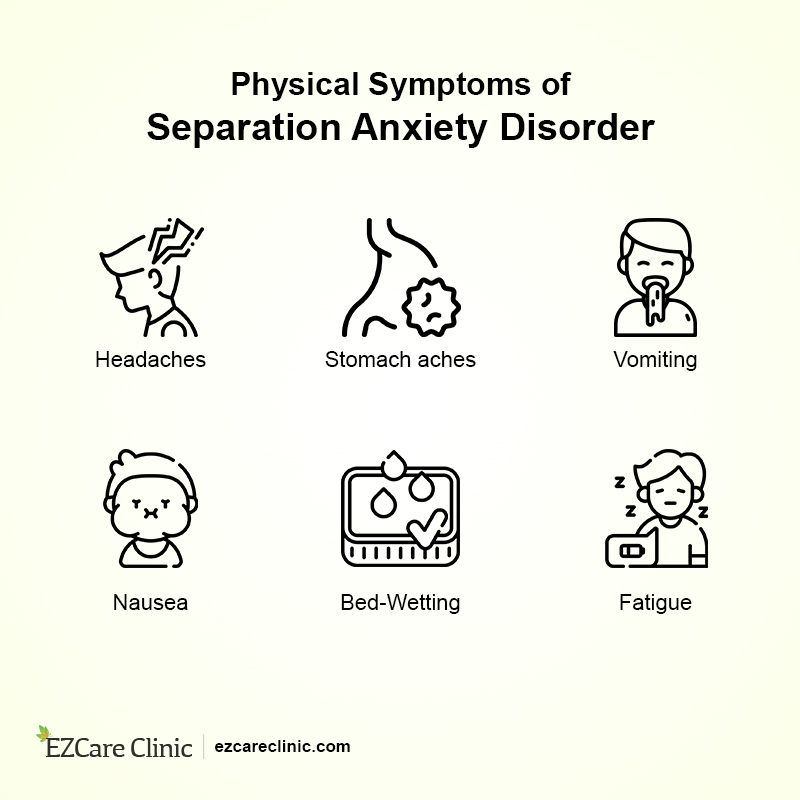
Physical Symptoms of Separation Anxiety Disorder
Are You at Risk of Developing Adult Separation Anxiety Disorder?
As mentioned above, more research is needed before reaching any conclusions regarding separation disorder. However, early evidence suggests women are more likely to develop separation anxiety. Other groups that stand a higher risk of experiencing SAD include people who’ve been divorced, separated, or are single.
Additionally, adults with a history of various psychological conditions are more vulnerable to developing a separation anxiety disorder. Some of the prevalent psychological disorders to note are:
- Anxiety disorders like post-traumatic stress disorder (PTSD) and generalized anxiety disorder (GAD)
- Major depressive disorders
- Substance abuse disorders
5. What Does Extreme Adult Separation Disorder Result in?
Separation anxiety disorder can have profoundly adverse effects on the affected person as well as those around them. When suffering from SAD, the accompanying stress and symptoms can make life hard and a harrowing and confusing experience every day.
Moreover, SAD also impacts the people around you and those you care about. Chronic clinginess and attachment can be more than enough to take for spouses, parents, friends, and even children. Therefore, a separation anxiety disorder can affect all spheres of your life, including the social, marital, and personal aspects.
Separation anxiety disorder in adults can be an indicator of underlying mental health disorders. Here’s more information on the longitudinal effects of adult separation disorder.
Effects of SAD on Relationships
Personal relationships are perhaps the most affected aspect of separation anxiety among adults. If you experience childhood separation anxiety disorder that carries over into adulthood, you’ll likely have difficulty forming meaningful and stable romantic relationships. Additionally, you may end up in unhealthy relationships where the other party takes advantage of you because of your attachment issues.
In most cases, adult separation anxiety disorder is damaging both to the affected person and their partner. Being overly protective, possessive, and vigilant can harm the personal space and comfort of your partner. Consequently, this may result in unnecessary arguments, fights, and mental pressure on both parties.
Get immediate anxiety treatment and live a normal life. Click the button below to book your appointment.
Social and Personal Impairments
Your social and personal lives are greatly affected by adult separation anxiety in countless ways. Some of the expected impairments resulting from SAD include:
- Lack of initiative and low interest in housework
- Decrease in work performance
- Lack of social interaction and engagement
- Lack of interest in studying
- Irritable and volatile mood swings
- Inability to take responsibility
- Extreme sensitivity
- Lack of focus on assigned tasks
Effects of Parental SAD on Children
Parental separation anxiety affects the parents as much as the children. The effects of SAD on children can carry on even when they are grown. For instance, children who grew up with parents suffering from separation anxiety are more likely to lack independence through adulthood.
Moreover, the children may develop rebellious and clingy tendencies as a coping mechanism. Worse still, there’s an increased chance the child will develop separation anxiety from the overprotective nature of their upbringing.
Effects of Separation Anxiety on Mental Health
When left untreated, a separation anxiety disorder can increase the likelihood of developing other mental health disorders. For example, people suffering from separation anxiety are five times more likely to get addicted to drug and substance abuse.
The fear of being separated can also affect your moods and increase the possibility of experiencing mood-related disorders like depression and anxiety. When experiencing a separation anxiety disorder, you’re also at a greater risk of developing personality disorders like borderline personality disorder and dependent personality disorder.
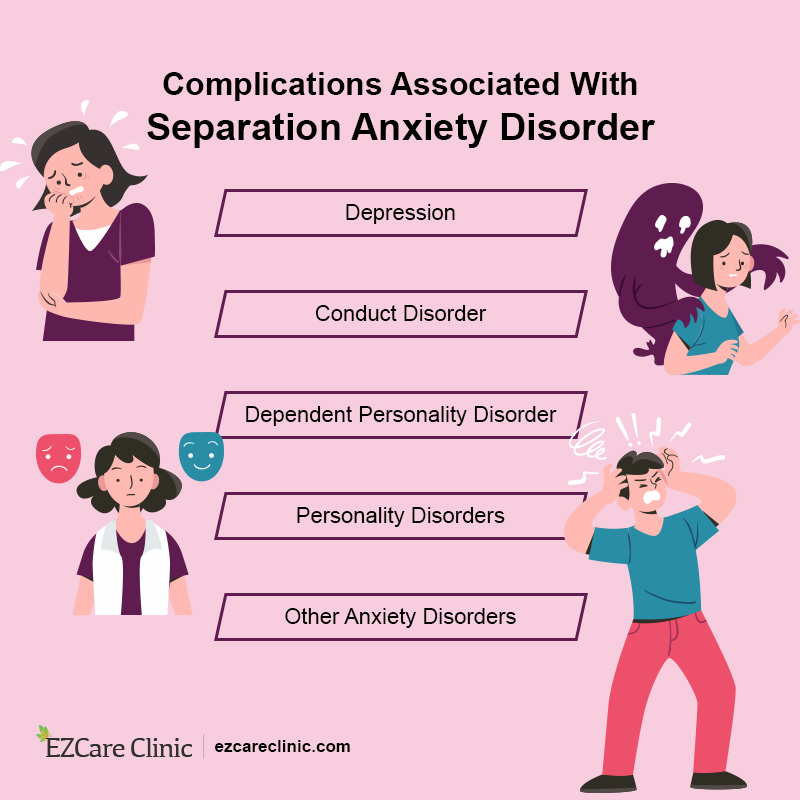
Complications Associated with Separation Anxiety Disorder
6. How Different Is a Separation Anxiety Disorder in Children from Adults?
For a long, separation anxiety disorder was thought to be a condition affecting children exclusively. The reasoning behind this was it is only in childhood years where being separated from family and loved ones can have a tangible negative effect on the kids. As a result of this notion, many adult SAD cases went misdiagnosed.
It wasn’t until recently when extensive research proved adults could also experience a separation anxiety disorder. After this research, adult SAD was formally recognized in DSM-V. The conclusion was adults, too, get highly anxious and distressed when they have to part ways with someone they have formed a solid emotional attachment to. In some cases, adults will spend a lot more time worrying about the possibility of being abandoned.
Separation Anxiety in Children
Separation anxiety in kids is characterized by feelings of stress and anxiety when placed in strange environments and situations or when distanced from family and loved ones. In most cases, SAD in children is observed between kids aged six months to 3 years.
As the child grows up, they start school, get new friends, and expand their worldview. As a result, they are less likely to experience separation anxiety. However, there will be instances where the child just wants to be with you, although these instances will gradually reduce with age.
Separation anxiety is normal in child development. However, if the child faces extended periods of stress and anxiety when you’re not near them, they could be developing separation anxiety. Of course, you should seek professional intervention before diagnosing your child with SAD.
Stages of Separation Anxiety in Children
Separation anxiety disorder can be categorized into three main phases. These are:
- The protest phase: During this stage, the child cries out loud, searches for the parents, and avoids interaction with other people.
- The desperation phase: In this stage, the child ceases crying and becomes inactive, withdrawn, sad, and lonely. The length of this stage varies from one child to another.
- The detachment phase: After prolonged separation, the child adjusts to the loss. They become more interested in the environment and start noticing others. The child will also form new relationships and play with others.
Contact us now for proper anxiety treatment or click the banner below to book your appointment.
Separation Anxiety in Adults
Unlike in the case of children, separation anxiety is not as common in adults. As you grow and mature into adulthood, you build your emotional strength and maturity. And while being separated from your family and loved ones can still affect you and make you sad, it will not result in extreme anxiety or make you feel left out.
Adults with separation anxiety experience heightened anxiety and stress levels. It is also common for adults with SAD to experience panic attacks when separated from loved ones.
Adults experiencing separation anxiety tend to be socially withdrawn and may feel extreme sadness. Those with this disorder may also find it hard to concentrate when separated from their loved ones. The fear of being detached from others can manifest in various ways, including being overly involved in their children’s lives. In other relations, adults with SAD may be characterized as overbearing and overprotective.
7. What Treatment Options Are Available for Adult Separation Anxiety Disorder?
It is quite unfortunate that most cases of adult separation anxiety disorder go untreated. In many instances, the condition may be misdiagnosed, or subsequent conditions get noticed first, like in Sharon’s case study above.
Moreover, since adult SAD is a relatively new addition to the DSM-V, there are limited treatment options available. More often than not, treatment for other anxiety disorders is used in SAD treatment.
If you suspect you’re developing or suffering from a separation anxiety disorder, it’s vital to seek professional help. Only a qualified professional can help you overcome SAD and lead a normal life.
SAD treatment options can be categorized into two major segments; non-medication treatment and medication treatment.
Non-Medication Treatment for Separation Anxiety Disorder
Non-medication remedies for SAD involve therapies and counseling and are the first choice in treatment options. The chief aim of these counseling and therapy sessions is to create awareness both to the patient and those close – family, friends, or spouse. The doctor could employ various psychotherapeutic techniques, including:
1. Cognitive-Behavioral Therapy (CBT)
CBT is one of the highly regarded techniques used in adults with SAD because they can freely express their feelings and thoughts. CBT focuses on the nervous feelings and thoughts causing separation anxiety. This could either be exaggerated ideas on what being alone feels like or a past loss causing them to be myopic. This therapy route involves three phases that include:
- Education – The clinician informs the patients about anxiety and how it affects them physically and mentally. This helps the patient improve their awareness and understand their reactions, allowing them to gradually reduce their overall response.
- Application – The patient learns how to apply various learning and behavioral techniques to real-life situations. This exposure is crucial as it offers practical and actionable exposure.
- Relapse prevention – Through continuous counseling, the client is informed of exposure and application techniques to prevent relapse and experiencing the symptoms.

Best Supplements for Anxiety
2. Exposure Therapy
Exposure therapy is one of the most effective and fruitful approaches. This technique involves exposing the patient to the situations they dread and helping them create adaptive solutions and behavior to the specific situations. Other methods like emotive imagery and systematic desensitization may also be used for the same purpose.
The principle behind exposure therapy is helping the patient to gradually overcome their fears and anxieties. The clinician will likely start from the small worries and work their way up to the major ones while helping the patient curate long-term solutions. Guided imagery helps the patient imagine a calm environment where they can mentally go when feeling afraid or anxious.
Medication Treatment for Separation Anxiety Disorder
Separation anxiety disorder remedial medication is reserved for extreme cases or where other treatment options fail. Currently, there is no specific prescribed medication for SAD. However, tricyclic antidepressants (TCAs), including clomipramine and imipramine, may be used.
Other medications proven effective for children and kids with SAD are selective serotonin reuptake inhibitors (SSRIs). It’s important to get explicit medical authorization and prescription before using any of these drugs.
8. How Do You Manage Separation Anxiety in Adults?
With the use of proper techniques, practice, and determination, adults have an easier time managing separation anxiety disorder than kids. There are various practices that can improve your tolerance and help you to cope with detachment.
If you’re only experiencing mild SAD symptoms, you should first try practical management techniques to overcome the symptoms and combat the situation. However, if the symptoms worsen, it’s advised to seek professional help for more assistance. Here are several practical and effective SAD management tips:
Tip# 1: Practice Mindfulness
Anxiety feeds on your fears and perceived threats. Whenever you focus on what you’re afraid of, you give anxiety an opportunity to overwhelm you. To overcome this, try and practice mindfulness techniques to help you focus on the here and now. These techniques also keep your mind from spiraling out of control and keep you grounded.
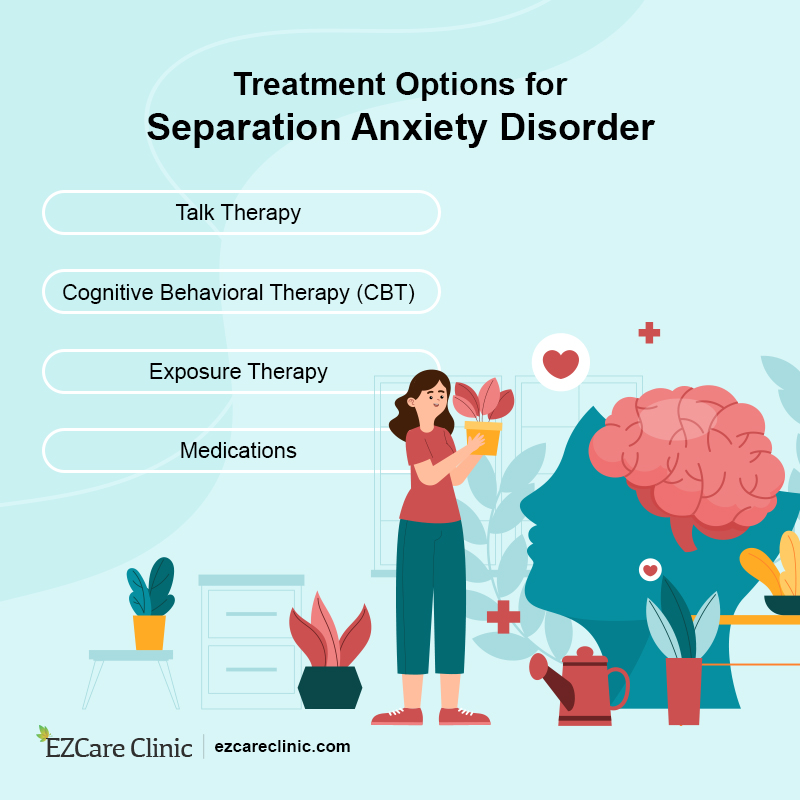
Treatment Options for Separation Anxiety Disorder
Tip# 2: Use Transitional Objects
Transitional objects are tangible items that represent a person or relationship you hold dear. By keeping these objects with you, you’ll feel connected and closer with the person. For example, you could have a friendship bracelet to remind you of a specific person. Whenever you feel anxious, you can wear the bracelet to connect with your favorite person, even when they’re not physically close.
Tip# 3: Apply Cognitive Dissonance
This is a practice where you actively separate thoughts that make you feel anxious. For instance, if you notice you’re feeling stressed about detaching from someone, you can choose to separate and classify these thoughts. Actively choose not to get stressed and analyze the thoughts when you’re in a calm and controlled environment.
Tip# 4: Talk with Other People
Like many other mental disorders, SAD can make you feel like you’re alone on an island. This could not be further from the truth. Everyone misses someone and feels sad when they’re not around their favorite person.
Whenever you think you’re getting overwhelming feelings, get someone to share what you’re going through. In most cases, the act of sharing alone can make you feel better. The other person could also offer advice to help you overcome these feelings.
9. How Can You Help a Friend Experiencing Separation Anxiety Disorder?
As mentioned above, seeking professional help is the only surefire way to deal with separation anxiety. However, just like in the case of SAD management, there’s what’s within your control. Here are several ways you can help a friend suffering from separation anxiety:
- Learn more about separation anxiety: Being informed and knowledgeable about the condition aid you in offering practical advice and assistance. Use credible resources to learn more about SAD and easy techniques to cope with the situation.
- Be supportive: Be supportive and understanding of what the person is going through. Spend time with them and help them understand this is not the end. Simply being there can help them feel better.
- Practice patience: It’s not always easy to recognize when someone is suffering from SAD. The person likely has no idea what they’re feeling or what to do with the thoughts and feelings. By being there, you could help them open up, and in the process, they may understand more about the condition in relation to how they’re feeling.
- Encourage them to seek help: Professional help is the best way to deal with separation anxiety. Talk to the person about the process of seeking help and the benefits of psychotherapy in combating the disorder.
Are you suffering from anxiety? Click the button below to book your appointment.
Takeaway
Ultimately, it’s important to recognize that separation anxiety disorder bears similarities with other mental health conditions. Just like many of these other conditions, failing to seek help can result in catastrophic consequences. If left untreated, separation anxiety can wreak havoc on your daily life and relationships.
Fortunately, with early detection, there are steps that both the professional and patient can undertake to overcome SAD and improve the quality of life. If you suspect you’re experiencing a separation anxiety disorder, try some of the abovementioned coping techniques and seek help to get back to your normal life.
Sources
- Diagnostic and Statistical Manual of Mental Disorders (DSM-5-TR)
Source link - How Worrying Affects the Body. (2022)
Source link
Contact us at EZCare Clinic for anxiety treatment or click the banner below to book your appointment.
